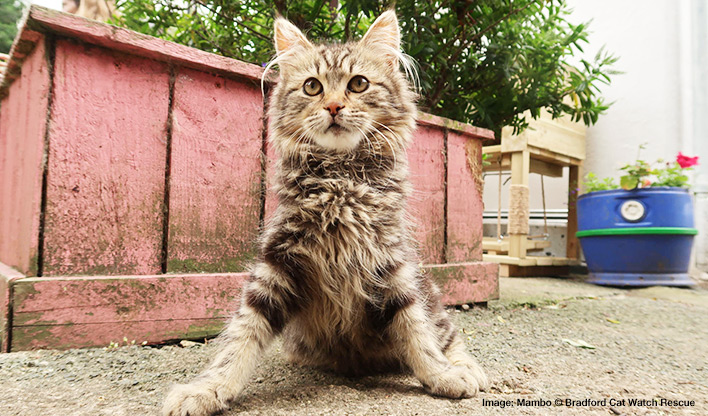Find out more about this rare feline neurological disorder.
With a little help from their humans, cats with Cerebellar Hypoplasia can live safe, happy lives. A little know-how, and a caring home with lots of love is really all you need.

Cerebellar hypoplasia in cats
Cerebellar hypoplasia, also referred to as ‘wobbly cat syndrome’ is a neurological condition that occurs when part of the brain called the cerebellum fails to develop normally. The cerebellum is located at the back of the brain and controls coordination and motor skills. It also helps to maintain balance and posture. It is a congenital condition and is not contagious.
Cerebellar hypoplasia is not a life-threatening or painful disease, but it is not curable once the damage has occurred, and there is no treatment. It is likely this condition will affect your cat’s quality of life to some degree but there are modifications you can make around your home to improve this. Let’s take a look at what causes cerebellar hypoplasia, and how you can help a cat born with this condition.
What causes cerebellar hypoplasia?
Cerebellar hypoplasia is usually caused when a pregnant cat is infected by feline panleukopenia virus (feline parvovirus), which then passes to her unborn kittens. This virus affects developing tissue and causes under-development of the cerebellum. Infection can also affect kittens up to the first few weeks after they are born as the cerebellum is still developing. There may be other causes of cerebellar hypoplasia (such as severe malnutrition in the pregnant cat) but feline panleukopenia is by far the most common cause.
What are the symptoms of cerebellar hypoplasia in cats?
The signs of cerebellar hypoplasia in cats depend on how extensively the cerebellum is affected. The cerebellum controls movement and coordination, so the symptoms include coordination problems and abnormal movements. These often first become evident when the kitten begins walking at around five weeks old.
Symptoms of cerebellar hypoplasia or ‘wobbly cat syndrome’ include:
- A wide leg stance
- Swaying or jerky movements
- High stepping gait
- Tremors and head bobbing
- Loss of balance
- Lack of coordination
You may notice these particularly when your cat tries to navigate things like litter trays or food bowls.
How is cerebellar hypoplasia diagnosed?
There is not a specific test for cerebellar hypoplasia. Your vet will most likely rule out other diseases using routine blood tests showing levels of blood cells and blood biochemistry. They may also use urinalysis. These tests will show if inflammation is present, or your cat has any metabolic issues or organ dysfunction. This will help to rule out any other diseases which may cause these symptoms.
You may wish to see a veterinary specialist for further diagnosis if your first opinion vet doesn’t have a definitive diagnosis. They may offer a cerebrospinal fluid tap which involves sampling the fluid around the brain and spinal cord to test for any viral or bacterial infections. MRI scans can also be used, and these can be useful to show the size of the cerebellum compared to a normal cat. This can help to give you a definitive answer. However, in most cases, diagnosis is based on abnormal movements in a kitten of the right age. Little or no testing is often adequate.
Cerebellar hypoplasia in cats: treatment
Cerebellar hypoplasia is a developmental disease meaning the damage is done before the cat is born, when the cerebellum is still growing. Because the cerebellum never develops properly in the first place, it cannot be ‘repaired’. This means there is no treatment for cerebellar hypoplasia and the condition will not improve over time.
What is the prognosis for a cat with cerebellar hypoplasia?
The severity of cerebellar hypoplasia varies. Most affected cats have mild to moderate cerebellar hypoplasia, although some can be severely affected.
Mildly affected cats have a tendency to lose their balance and have subtle tremors when scared or excited but are still able to move fairly normally most of the time.
Moderate cerebellar hypoplasia cats have the characteristic high stepping gait along with the wide leg stance and more noticeable tremors, especially when they are scared. They will struggle more with balance, frequently falling over and will find it harder to jump.
Severely affected cats will require lots of modifications around the home, as they will most likely not be able to stand for long without falling over. This will impact them greatly as they will struggle to eat and drink and use a litter box.
The prognosis is good for mild to moderately affected cats and they are usually able to live happy, healthy lives. These cats have a normal life expectancy as this is not a painful or progressive condition, and even the more severely affected cats can learn to compensate over time.
Prevention of cerebellar hypoplasia
The simplest way to prevent cerebellar hypoplasia is by vaccinating the mother cat against Feline Panleukopenia. Anyone involved in the breeding of cats should ensure this is done, and after the initial course, a booster will be needed every three years. This vaccination is only effective in preventing cerebellar hypoplasia developing - once a kitten has been affected there is no way to prevent further damage.
It is best to neuter cats with cerebellar hypoplasia as it may have some genetic causes and this is not a condition we want to risk passing to the next generation.
Things you can do to help your cat with cerebellar hypoplasia
Although there is no treatment, there are some changes you can make to improve your cat’s quality of life, such as:
- Cats with cerebellar hypoplasia are more accident-prone, so it is best that they live indoors where they will be safer. Alternatively, a fully secure garden or catio would allow your CH cat to safely enjoy the outdoors.
- Keep any claw trimming to a minimum. The extra grip will help with his balance.
- Provide a large litter box with tall sides to prevent him falling out. Bear in mind that his coordination is not as good, so ensure he can comfortably get in and out at one end.
- Increase his mobility by placing non-slip mats on smooth or shiny floors.
- Put up stair gates in your house to prevent falls.
- Wide food and water bowls with non-slip mats underneath, will make eating and drinking easier.
- Ensure your cat has easy access to chairs or sofas – steps or a ramp can be helpful.
- You can put cushions or mats in places that he may be likely to fall off (such as under windowsills).
- Keep a variety of toys around the house, and play with your CH cat often. This will strengthen his muscles, and help his balance.
- Give your CH cat plenty of love and cuddles!
Conclusion
Most cats with cerebellar hypoplasia can adapt very well to living with the condition, and adjustments like these will help give your cat a more normal and happy life. As there is no treatment, it is best to prevent the condition occurring in the first place, so always ensure your cats are neutered and fully vaccinated.
 CH cats have just as much love to give as any other, and deserve to be living their best life. Whilst they will need extra TLC, the rewards are enormous! If you are thinking of adopting a CH cat, check out the links in the Further Information section below.
CH cats have just as much love to give as any other, and deserve to be living their best life. Whilst they will need extra TLC, the rewards are enormous! If you are thinking of adopting a CH cat, check out the links in the Further Information section below.
Further Information
Find Rehoming Centres near you
Cats Protection - Cats with Cerebellar Hypoplasia
Life With Cerebellar Hypoplasia Cats
Cerebellar Hypoplasia cat Weeble - video
Contributor: Veterinary student Tabitha Gammage under the supervision of Dr Joanna Woodnutt MRCVS of The Veterinary Content Company.
Published: December 2021
Grateful thanks to Bradford Cat Watch Rescue for the photos on this page. Bradford Cat Watch Rescue specialises in the care of cats who are physically and psychologically vulnerable. They use their 'SENSE' framework (Safe • Enriching • Nurturing • Sensory • Environment) when working with special needs cats; believing that these 5 elements of care lead to the best possible quality of life.

